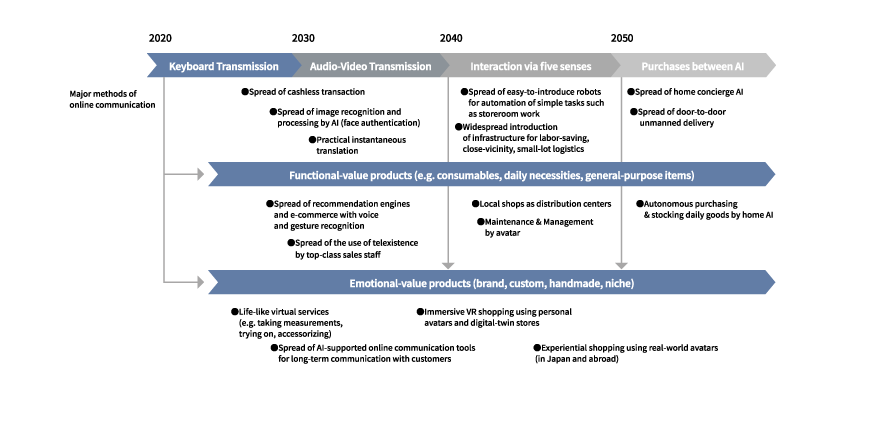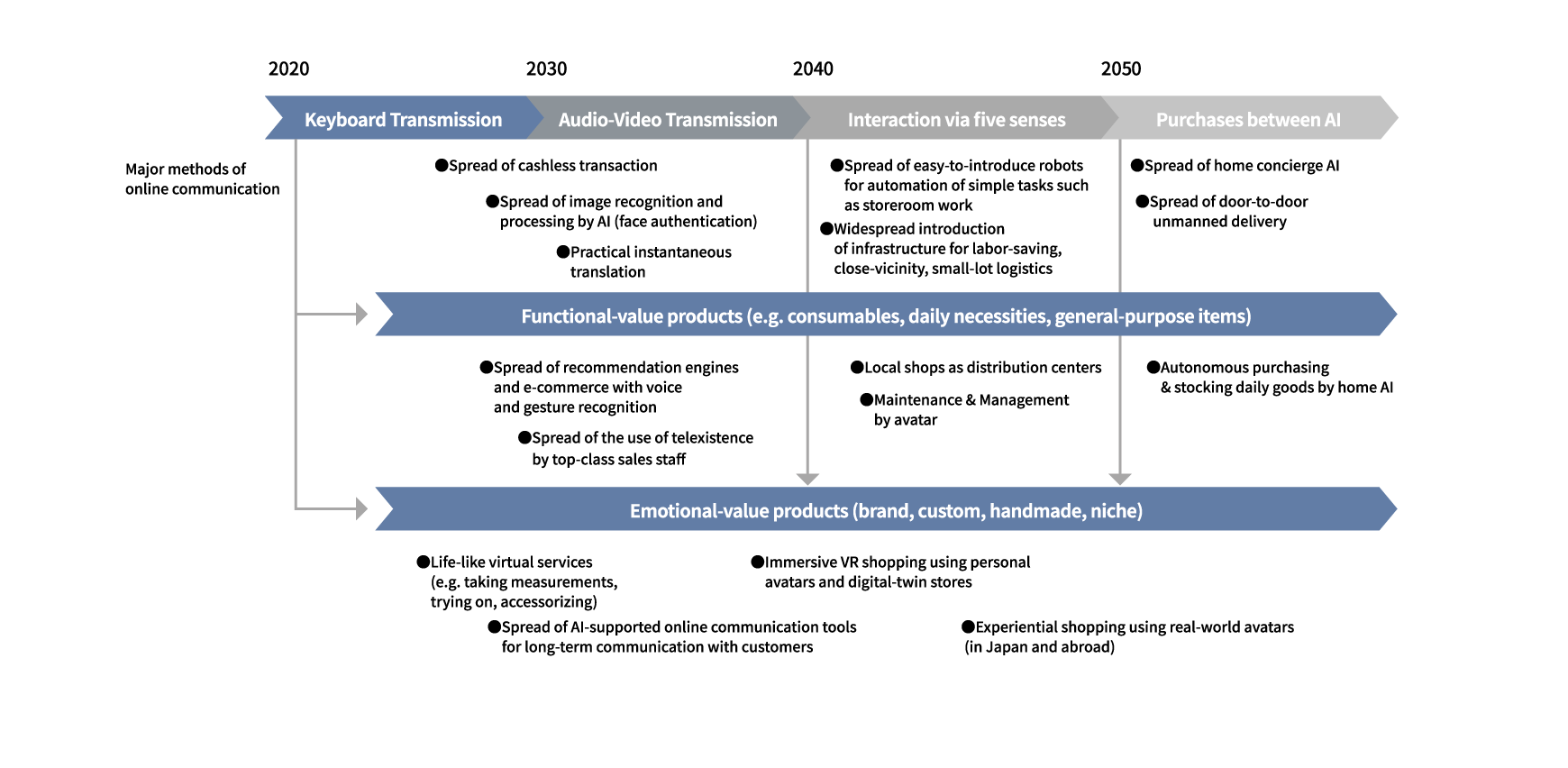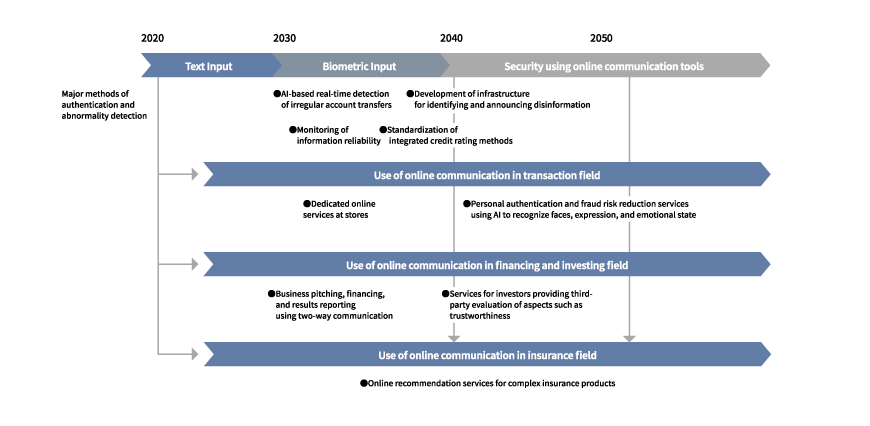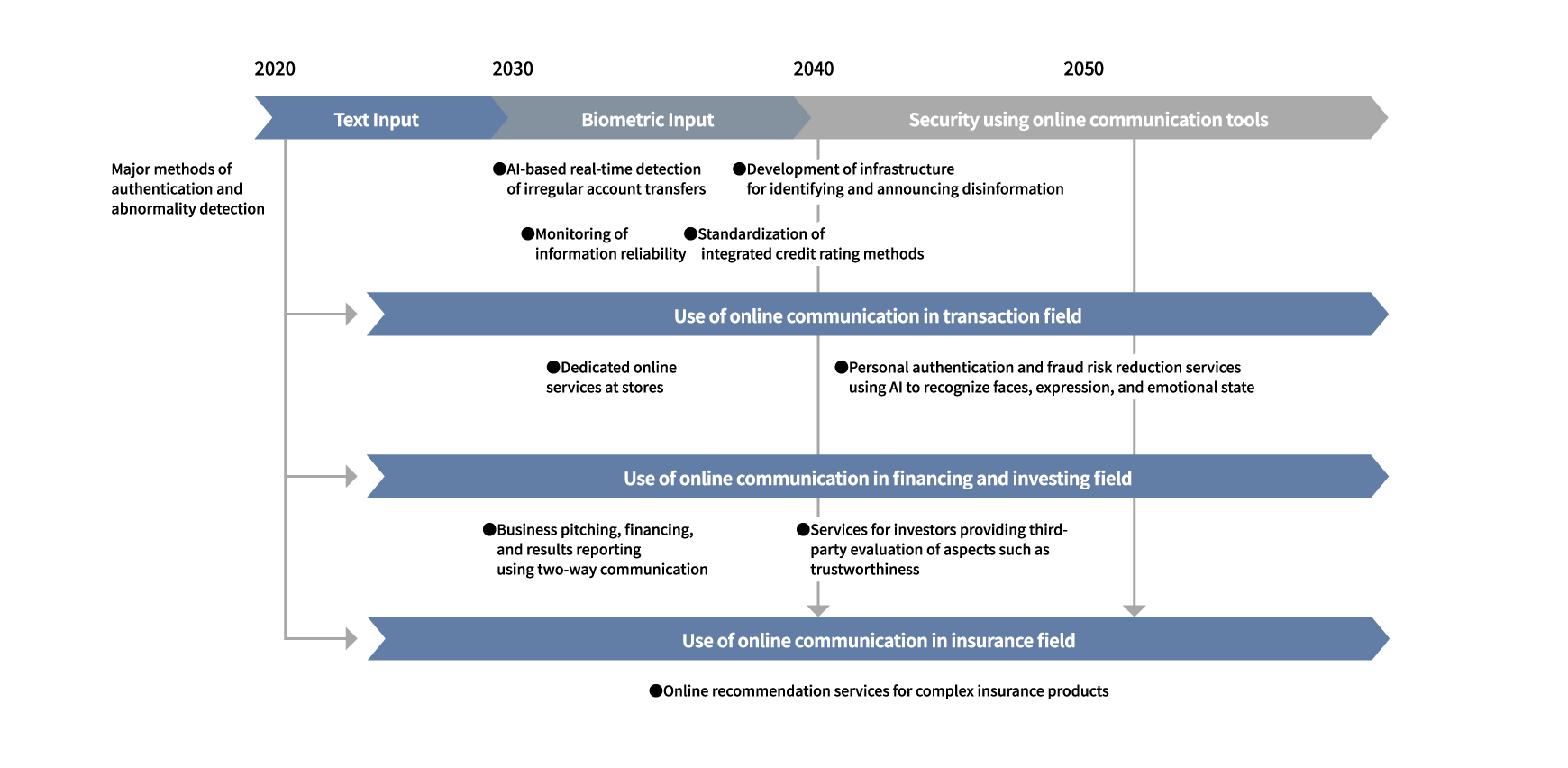
How Online Communication will Evolve in the Post-COVID-19 Era
Online Communication to Transform Retail and Financial Services
Introduction
The COVID-19 pandemic has caused an abrupt shift toward online communication. Based on audio and video, the current prevailing technologies are unable to transmit the volume of information shared in real-world interactions. However, online communication continues to see increasing use and decreasing barriers related to time and space, and more people are coming to recognize the benefits of communicating virtually including the various accompanying assistance features that can be used during conversations such as information search, display, and recording tools. For this reason, online communication is expected to maintain its popularity as a useful tool for communicating even following the COVID-19 pandemic.
Despite the limits of current online communication tools, development is underway on many new technologies that may eventually enable online communication to compete with or even surpass in-person communication. Part 2 of this series offers an overview of such technological advancements.
Online communication is typically considered to consist of the transmission of thoughts and information between people in separate locations, but it can be asserted that online communication also includes exchange between people and machines. The following explores the people-to-machine concept and offers a vision of future application of such online communication in the retail and financial sectors.
Consumer Expectations Surrounding Retail Services
The retail industry is extremely broad in scope, covering a variety of products, methods of sale, and sources of value. Retail products can be divided into two categories. The first is products centered on functional value, including daily necessities and general-purpose goods. The second is products centered on emotional value, including brand and craft items, which have a core functional element but derive a majority of their value from emotional benefits.
Previously, reasonable products lagged far behind their expensive counterparts with regard to performance and functionality, characterized by the adage, “you get what you paid for.” However, manufacturing technologies have advanced worldwide, and a certain standard of quality is expected regarding product management systems. Furthermore, many products centered on functional value have become commodified due to a state of oversupply in many countries. To differentiate commodified products, companies generally strive to compete on two points: lower price and better availability.
The dynamics flip-flop for products centered on emotional value, including brand products, customized items, limited-production crafts, and niche products. While emotional-value products must satisfy a basic standard of functionality, their functional benefits have little influence on their marketability. For these products, customer satisfaction must be maximized across the entirety of the product life cycle from purchase to disposal.
The subject and use of online communication differs for functional-value products and emotional-value products. For the former, machines, particularly AI, are expected to serve a central role in communicating with customers in light of pressure companies face to offer lower prices and easier access.
For the latter, AI and other technological support is expected to be employed in online communication, but workers are to remain at the core of in-person interaction with customers as a means for companies to improve satisfaction throughout the product life cycle.
Retail Services to Evolve through Online Communication
Figure 1 presents an outlook of online communication services in the retail sector.
The top of Figure 1 shows changes in the means of online communication. For person-to-person and person-to-machine communication, technologies are expected to evolve from text-based to voice and image-based before progressing to sensory-based transmission of product information. Autonomous purchasing will become the norm and features exchange from AI to AI without human intervention.
(1) Outlook of functional-value products
In the case of functional-value products, customers focus on low prices and ease of acquisition. To make acquisition easier, brick-and-mortar stores will adopt omnichannel marketing, making the use of online communication tools a standard practice. Communication in this context occurs between customers and the store's AI.
Many e-commerce sites today use text-based search engines to help customers find the products they want, with purchasing decisions made via button clicks. However, in the near future, many e-retailers will flexibly respond to customers' voice and gesture commands to recommend products and process sales. Products themselves will be increasingly shipped from nearby physical stores directly, and such shops will serve a key role as delivery bases in light of shipping-process automation. Ultimately, the customer's home AI will communicate with the AI of stores to replenish daily necessities and consumables without any human involvement.
(2) Outlook of emotional-value products
In the case of emotional-value products, value is derived not only from the product itself but also from the entire series of experiences starting with purchase through use and ending with disposal. Experiential specifics include store atmosphere and location, customer service, after-sales service, and methods of disposal following use. Online communication tools will be used as a potent means of providing this series of experiential value to customers and of enhancing their loyalty to the store and brand.
Customer experience and brand loyalty are greatly influenced by interactions with trained, professional personnel. In the face of a lack in human resources, customer service by human professionals has been focused on the actual selling of products, particularly high-end ones, out of necessity. However, retailers will be able to effectively increase customer satisfaction throughout the product lifecycle by supporting personnel with AI, office automation, and online communication tools. Moreover, upon the successful integration of real and virtual worlds, retailers will have the opportunity to transcend the limits of time and space to acquire new customers from around the world and to grow their store and brand fanbase.
Consumer Expectations Surrounding Financial Services
This section discusses financial services for general consumers. Financial services must be economically reasonable, and the most basic customer expectations are immutable: 1) no or minimal fees associated with services such as deposits and loans, 2) fast and simple procedures, and 3) secure and reliable transactions.
The financial service industry must work to automate, unman, and take-online standardized work, for which secure transaction of customer assets will be an important prerequisite. Concurrently, financial retailers must develop systems for meeting varying levels of IT literacy among their wide spectrum of customers.
Financial Services Supported by Online Communication
Moving financial services online allows consumers to transfer, borrow, and invest money at home. As long as the security of consumer assets is ensured, this convenient type of service will continue to increase in use in the post-COVID world.
However, less human involvement in services increases the risk that consumers will be directly exposed to disinformation and fraud. Online communication tools should be used as an aid to reduce this risk.
Online banking at present most often requires the input of textual information for authentication, such as an ID or security code. Going forward, authentication may be fortified through the spread of means such as biometric authentication, particularly facial authentication. Money transfer fraud is characterized by the manipulation of a victim’s psychological state often to induce irrational decisions based on emotional reaction. Banks can use AI to check customer emotions and, when an abnormality is detected, contact a service representative. Furthermore, by reaching out online to a customer potentially a victim of such fraud, the representative could halt the transaction and prevent financial loss.
Online communication also has the potential to lower the cost of consultation services that explain the risks and benefits accompanying specific financial and insurance products.
Financial Services that will Evolve with Online Communication
Figure 2 presents an outlook of online communication services in the finance industry.
(1) Banking
Nearly all transaction services will eventually be automated, and this shift will first begin with the reduction of human labor in front-end services with support by people stationed in the back-office. Since online payments will become the norm for customers, facial and emotional authentication will be used not only for personal identification but as a measure to determine whether the user is in an abnormal emotional state. Experts will provide remote support online for dedicated services such as savings and loans.
(2) Investing
Based on current ESG investing trends, growth is projected for the direct investment of personal assets in companies and businesses that are socially beneficial and generate positive feelings for the investor. Online consulting services will go to the mainstream that assess those companies based on their trustworthiness, disclosed information, and activities to help retail investors find products that meet their preferences. Furthermore, two-way communication will arise in which members of the organization receiving investment will be able to disclose activities to investors.
(3) Insurance
With the use of integrated credit reports growing, marketing will takeoff for complex insurance products targeting various consumer segments. Online consulting services will provide explanation of these complex products and make recommendations based on individual customer needs.
Conditions to be Met for the Spread of Online Communication Services in Retail and Finance
For functional-value products, the key to competitiveness will lie in a retailer’s ability to both set lower prices and eliminate the time and effort customers spend on making purchases. Online communication tools in this area will likely be applied to unmanned stores so that the store's AI system will, when searching for products or processing a purchase, detect and provide an appropriate response to a customer’s natural language and gestures. Development will be essential to achieve a distribution infrastructure that ships purchased products to the required destination quickly and inexpensively.
For emotional-value products, competitiveness will be determined by retailers' ability to deliver positive experiences throughout the product life cycle. Online communication tools will be used to build and maintain customer relationships. Systems will need to be developed that allow retailers to create the atmosphere of their physical stores and expand such stores into the virtual world, in addition to providing real experiences to remote customers using various VR and telexistence technologies. Also important will be the development of subscription service options that allow even small retailers to use VR platforms and telexistence avatars.
In the finance industry, online services themselves will continue to advance, but the use of online communication tools is likely to be limited. Although online communication tools have potential to be of use in preventing fraud through means such as biometric facial authentication and psychological-state recognition, difficulty will likely arise in establishing public consensus over the use of personal information in such applications.




